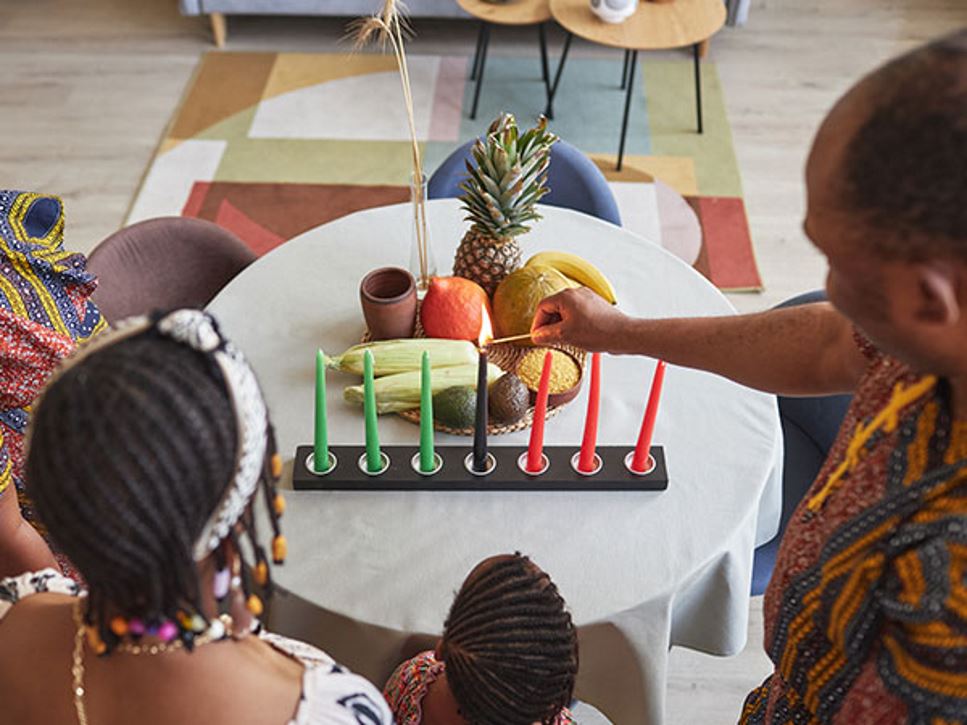Celebrated from December 26 through January 1, Kwanzaa is primarily an African American holiday observed in the United States to honor African heritage in Black culture, but it also may be celebrated in other parts of the world. The celebration began in 1966, named and initiated by Maulana Karenga, PhD, a professor and activist.
The term “Kwanzaa” is derived from the Swahili phrase “matunda ya kwanza,” which loosely translates to “first fruits of the harvest.” The idea of Kwanzaa combines different African first fruits harvest celebrations.
Kwanzaa Traditions
A table is decorated with certain symbols of Kwanzaa, such as the kinara (candleholder). The candles in a kinara represent each of the seven principles of Kwanzaa, which are called Nguzo Saba. The kinara features three red candles, three green candles and one black center candle, also known as the unity candle.
Each night, one of the seven candles is lit — starting with the black candle, then the red candle on the immediate right, then the green candle on the immediate left, and so on — and one of the seven principles is discussed:
- Umoja (black candle): The unity of the race, community and family
- Kujichagulia: Self-determination and accountability
- Ujima: Collective work and responsibility
- Ujamaa: Cooperative economics by working together to build businesses
- Nia: Purpose in remembering African and African American history and culture
- Kuumba: Creativity in the community
- Imani: Faith in people
Kwanzaa has seven symbols:
- Mkeka: A straw mat that represents history, culture and tradition
- Mazao: Nuts, fruits and vegetables placed on the mkeka to represent the family’s crops or harvest
- Muhindi: Ears of corn that represent the future, children in the family and children in the community
- Kinara: A candleholder that symbolizes the roots of the community
- Mishumaa Saba: The seven candles that are placed on the kinara
- Kikombe Cha Umoja: A unity cup passed from person to person to promote unity during the large meal
- Zawadi: Handmade gifts for the children
In addition to the kinara, the table is decorated with a mkeka, muhindi, mazao and zawadi.
Common Kwanzaa Celebrations
While every family observes Kwanzaa in its own way, celebrations may include singing and dancing or playing African drums. Some families may share stories or read poems. Typically, a large traditional meal called karamu is served on the sixth day of Kwanzaa.
Karamu is made up of foods from African, Caribbean, South American and Southern cuisines. Foods served can differ greatly from family to family, but there are two foods with significant symbolism: black-eyed peas and collard greens.
Black-eyed peas are associated with good luck, and collard greens are said to represent money or fortune. Black-eyed peas are a good source of protein, dietary fiber and iron. Collard greens, a green leafy vegetable, deliver a variety of nutrients including vitamins A, C, K and folate plus antioxidants, fiber, and minerals including magnesium, calcium, iron and potassium.
Other foods typically eaten during karamu are jollof rice (a flavorful African rice dish made with crushed tomatoes, red onions, green peppers, a hot pepper, tomato paste, spices and vegetable broth), African peanut stew (a flavorful, hearty stew made with chicken, peanut butter, tomato paste, ginger and fresh herbs), fried chicken or fish, candied yams, macaroni and cheese, corn bread and sweet potato pie for dessert.
Find a Nutrition Expert
Looking for credible nutrition information and recommendations? The Academy of Nutrition and Dietetics' network of credentialed food and nutrition practitioners are ready to help!

